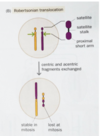DNA synthesis, repair and recombination 2 of 2 Flashcards
What does DNA recombination include?
what are the types of DNA recombination
- DNA recombination
- breakage
- exchange
- rejoining
- homologous
- generally occurs between the complementary strands of homologous DNA molecules
- DNA repair
- generally occurs between the complementary strands of homologous DNA molecules
- nonhomologous
- occurs between different DNA molecules
- Meiosis
- occurs between different DNA molecules
List the three benefits to recombination
- greater variety of offspring
- generates new combinations of allels
- negative selection
- remove deleterious alleles from a population w/o removing the entire c’some carrying the allele
- essential to meiosis
- failure to keep homologous c’somes together prior to anaphase can lead to averrant number of c’soms
- to little=monisomy
- to many=trisomy
- failure to keep homologous c’somes together prior to anaphase can lead to averrant number of c’soms
why is recombination needed for meiosis?
keep maternal and paternal homologs of c’somes together prior to anaphase-1 of meosis.
- prophase 1
- crossing over between maternal and paternal chromosomes-prophase 1
- metaphase
- Csomes line up on m-plate
- anaphase 1
- homologous chromosomes separate and move to 2 daughter cells
- centromeres of maternal and paternal c’somes separate, but c’somes are held together at chiasmata (cross overs)
describe the DNA repair and recombination.
this is not meiosis!
- double strand break
- exonuclease degrades ends
- single-strand invade HOMOLOGOUS area of sister chromatid
- DNA polymerase extends 3’ ends, and the branch point migrates
- newly syntthesized strand pairing with top strand
- the gap on the top strand is filled in by DNA polymerase
- Ligase binds the DNA back together

explain crossing over in meiosis
aka: homologous recombination (this is not repair)
- proteins melt strand
- exonuclease degrades portion of 5’ strands, leaving a section of the 3’ end overhanging
- 3’end invades the same region of the homologous chromosome
- DNA polymerase synthesizes the DNA
-
holiday junction is resolved
-
two options
- same direction of cuts
- no crossing over
- different direction of cuts
- YES CROSSING OVER
- same direction of cuts
-
two options

diagram and explain the holiday junction and form
structure is transient, but the resolve of this structure allows for the recombination of homologous chromosomes

differentiate between gene conversion and crossing over
- gene conversion
- one way of transfering information, resulting in an allele on one parental chromosome being changed to the allele from the other homologous chromosome.
- Crossing over
- the holiday junction resolves by exchnaging the entire portion of a chromosome, instead of just an allele.

A patient has a karyotype of the following. What has taken place?

reciprical translocation
- movement of chromosome material between NONHOMOLOGOUS chromosomes
- stability
- stable
- when one aacentric fragment is exchanged for another
- unstable
- when centric and acentric fragments are exchanged
- stable

a pattient has karyotype of the following, explain what happened

robertsonian translocation
- highly specialized reciprocal translocation of the rRNA regions of a c’some
- produces
- acentric chromosome
- lost in meiosis
- dicentric chromosome
- stable in meiosis
- acentric chromosome
- occures exculsively on the following c’somes
- 13,14,15,21,22
- loss of these small acentric fragments has no phenotypic consequences b/c of the large copy number of these genes on other c’somes

diagram the possible outcomes of reciprocal translocation
carrier of a balanced reciprocal translocationcan produce gametes that give rise to
- normal child(1/4)
- balnced carrier(1/4)
- partial trisomy (1/2)- these are different
the length/size of the break point determines the viability of the fetus.
- large- increase chance of abortion
- small-increase chance of birth, with abnormalities

diagram the possibilities of a carrier of a balanced robertsonian translocation
possible outcomes
- normal(1/6)
- balanced carrier(1/6)
- trisomy (1/3)
- monosomy(1/3)

a segment of DNA that can move from their original position to a new position of the genome.
explain known methodology
Transpons
- they contain transposase
- cleaves the transposon from the genome and moves it to a new location
- transposons are bordered by the direct repeats
- transposons can cause genomic instability by either insertions or rearrangments



